Exam Details
Exam Code
:4A0-103Exam Name
:Nokia Multiprotocol Label SwitchingCertification
:Nokia CertificationsVendor
:NokiaTotal Questions
:249 Q&AsLast Updated
:Apr 13, 2025
Nokia Nokia Certifications 4A0-103 Questions & Answers
-
Question 101:
Click on the exhibit.
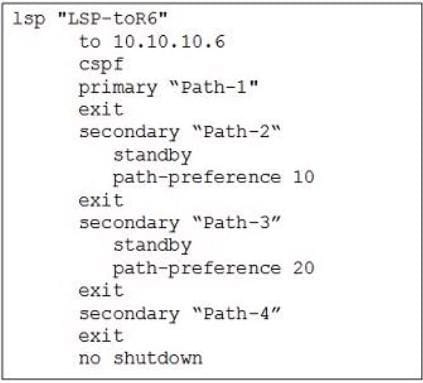
Both Path-1 and Path-2 are down. If Path-2 becomes available again, how does the headend router select the secondary LSP path?
A. The router will switch to Path-2 because it is the first secondary path configured in the list.
B. The router will not switch to Path-2 because the current path has the longest uptime.
C. The router will switch to Path-2 because it is a more preferred path.
D. The router will not switch to Path-2 because the router will not revert to another secondary path.
-
Question 102:
Which of the following about an LSP protected with one-to-one FRR is TRUE?
A. The LSP can use facility and one-to-one FRR simultaneously.
B. The LSP is limited to node protection.
C. A single protection tunnel is used for all LSPs with the same path.
D. A detour protection tunnel is created for the LSP.
-
Question 103:
Click on the exhibit.
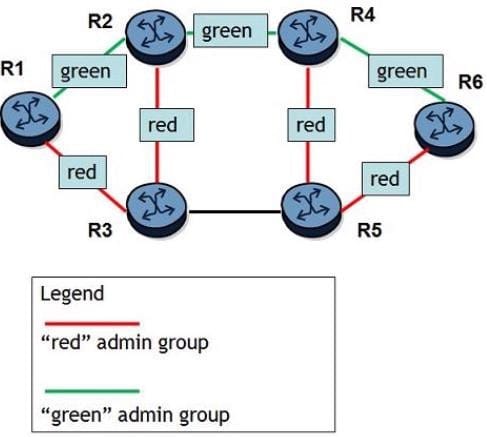
All links are of equal cost. A CSPF-enabled LSP is configured on R1 to R6. Its fully loose primary path is configured with an "include green" statement and the fully loose secondary path is configured with an "include red" statement.
Which paths will be taken by this LSP?
A. No primary path is established. The secondary path will take R1-R2-R4-R6.
B. The primary path will take R1-R3-R5-R6. The secondary path will take R1-R2-R4-R6.
C. The primary path will take R1-R2-R4-R6. No secondary path is established.
D. The primary path will take R1-R2-R4-R6. The secondary path will take R1-R3-R5-R6.
-
Question 104:
Click on the exhibit.

All links are operationally up initially. When the link between routers R4 and R6 goes down, what will router R1 do?
A. Router R1 will switch traffic to the secondary path immediately.
B. Router R1 will discard traffic until a new IGP route to router R6 is re-calculated.
C. Router R1 will discard traffic because the secondary path is not a fully strict path.
D. Router R1 will signal the secondary path and switch traffic to it.
-
Question 105:
Click on the exhibit.

Which of the following about the bypass tunnel is FALSE?
A. The router 10.10.10.1 is a PLR providing node protection for the router 10.10.10.3.
B. One-to-one fast reroute protection is requested by an LSP.
C. The bypass-link tunnel is used to avoid the link with the egress interface address 10.3.4.4.
D. The bypass-node tunnel is used to avoid the next-hop downstream router 10.10.10.3.
-
Question 106:
Click on the exhibit.
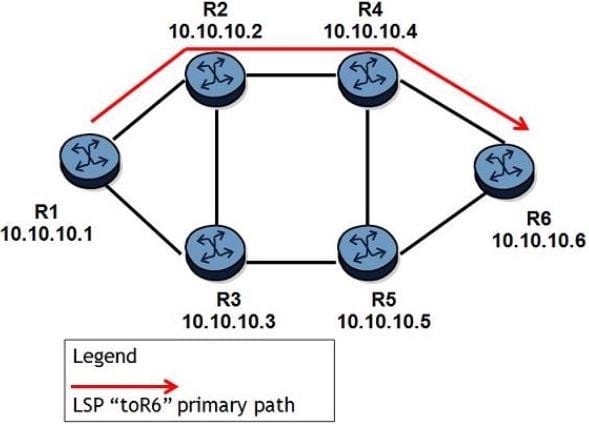
An LSP traverses R1-R2-R4-R6 and facility fast reroute with link protection is enabled. All links have the same cost. Which of the following about PLRs and MPs is TRUE?
A. R1, R2, and R4 can be PLRs; R6 is the MP.
B. R1, R2, and R4 can be PLRs; R2, R4, and R6 are MPs.
C. R1, R2, R3, R4, and R5 can be PLRs; R6 is the MP.
D. R1, R2, R3. R4, and R5 can be PLRs; R2, R4, and R6 is the MP.
-
Question 107:
Click on the exhibit.
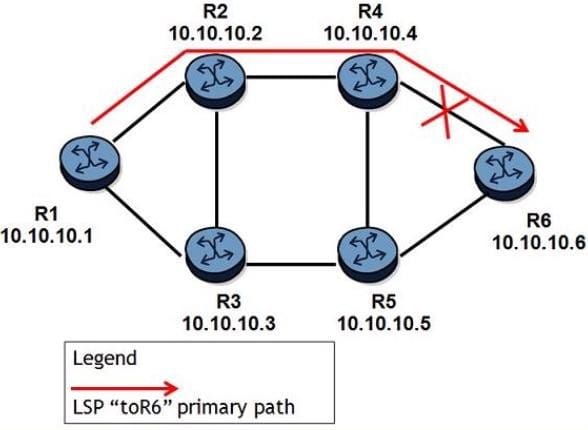
An LSP path is established on router R1 toward router R6. After router R4 detects that the link between routers R4 and R6 goes down, which of the following will affect the failure propagation time?
A. The time router R4 takes to send a PATH Error message toward the head-end router.
B. The time router R4 takes to detect RSVP Hello message timeout from router R6.
C. The time router R4 takes to send a RESV Error message to the head-end router.
D. The time router R1 takes to signal an alternate path through router R3.
-
Question 108:
Using facility mode fast reroute, how does the PLR learn the address of the MP?
A. The PLR issues an RSVP PATH message to the tail-end requesting the address of the MP.
B. The PLR learns the address of the MP from the ERO.
C. The PLR learns the address of the MP from the RRO.
D. The PLR learns the address of the MP from the targeted RSVP Hello message.
E. The PLR knows the address of the MP is the same as the tail-end router.
-
Question 109:
Click on the exhibit.
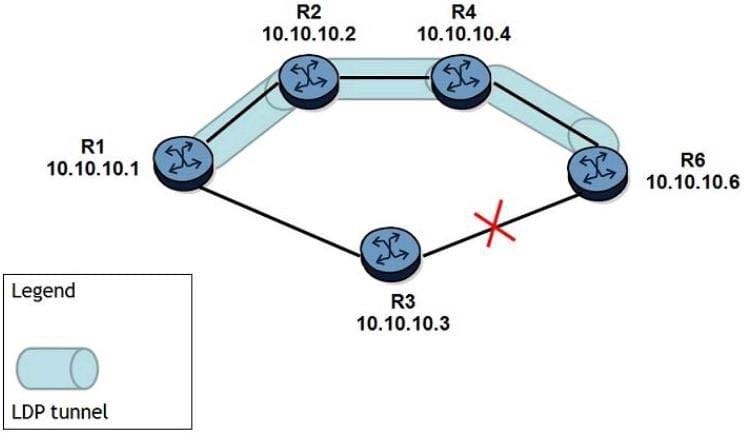
An LDP tunnel is established on R1-R2-R4-R6 because the link between routers R3 and R6 is down. With the LDP-IGP Sync feature enabled and after the link is restored, which of the following is FALSE?
A. Router R3 starts the LDP-Sync timer after recovering the LDP session on R3-R6.
B. Router R1 continues to use R1-R2-R4-R6 until the LDP-Sync feature is disabled.
C. Router R3 advertises the maximum metric for the link to router R6.
D. Router R1 receives a label from router R3 after the LDP session is established on R3-R6.
-
Question 110:
Which of the following about MPLS fast reroute is TRUE?
A. Fast reroute is used when redundant links are not available.
B. Fast reroute provides path protection close to the failure point.
C. Fast reroute provides fast failure detection to the head-end router.
D. Fast reroute protects both primary and secondary paths.
Related Exams:
4A0-100
Nokia IP Networks and Services Fundamentals4A0-101
Nokia Interior Routing Protocols4A0-102
Nokia Border Gateway Protocol for Internet Routing4A0-103
Nokia Multiprotocol Label Switching4A0-104
Nokia Services Architecture4A0-105
Nokia Virtual Private LAN Services4A0-106
Nokia Virtual Private Routed Networks4A0-107
Nokia Quality of Service4A0-108
Nokia Multicast Protocols4A0-109
Alcatel-Lucent Triple Play Services
Tips on How to Prepare for the Exams
Nowadays, the certification exams become more and more important and required by more and more enterprises when applying for a job. But how to prepare for the exam effectively? How to prepare for the exam in a short time with less efforts? How to get a ideal result and how to find the most reliable resources? Here on Vcedump.com, you will find all the answers. Vcedump.com provide not only Nokia exam questions, answers and explanations but also complete assistance on your exam preparation and certification application. If you are confused on your 4A0-103 exam preparations and Nokia certification application, do not hesitate to visit our Vcedump.com to find your solutions here.